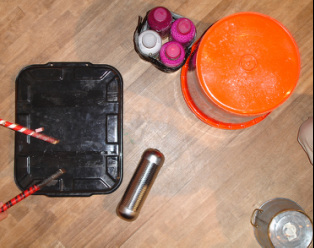
I started teaching junkyard percussion about ten years ago completely by accident and somehow have found new places and people to teach ever since. What started as a solution to not having enough drums for a summer camp has evolved into something I include in all of my K-12 general music teaching.
As a percussionist, my goal is to make classroom bucket drumming as authentic and rigorous as possible. Students build technique, learn ensemble skills like cueing, moving, and knowing your musical role and how to perform without a conductor. The hypothetical litmus test would be a percussion colleague observing class or a performance and saying something like "Yeah, that's legit."
As a middle school general music teacher, my primary goal is for students to learn rhythm patterns and steady beat, and discern meter. Students get an authentic musical experience as they take on the roles of performers, composers, and improvisors. There are many opportunities for ownership as students create compositions that use rhythms and patterns that are relevant to their musical lives.
Students need to learn actual cognitive musical skills while drumming, not just have a "fun" time in music class. This is the danger with any sort of group drumming: The experience is immediately positive and directly emotional and that response can be confused with learning (and good teaching). But if no actual music learning takes place, you are simply a motivational speaker.
The Bucket Book emerged as a way of organizing and sequencing the activities and materials that I use each day in class. The Bucket Book takes music seriously and focuses on quality music. There are no gimmicks or filler. This blog will augment the book with videos, resources, and musical examples and to generally chronicle what is going on in my music classes that use bucket drumming.
The Bucket Book will be published by Alfred Music Publishing in October 2014.
As a percussionist, my goal is to make classroom bucket drumming as authentic and rigorous as possible. Students build technique, learn ensemble skills like cueing, moving, and knowing your musical role and how to perform without a conductor. The hypothetical litmus test would be a percussion colleague observing class or a performance and saying something like "Yeah, that's legit."
As a middle school general music teacher, my primary goal is for students to learn rhythm patterns and steady beat, and discern meter. Students get an authentic musical experience as they take on the roles of performers, composers, and improvisors. There are many opportunities for ownership as students create compositions that use rhythms and patterns that are relevant to their musical lives.
Students need to learn actual cognitive musical skills while drumming, not just have a "fun" time in music class. This is the danger with any sort of group drumming: The experience is immediately positive and directly emotional and that response can be confused with learning (and good teaching). But if no actual music learning takes place, you are simply a motivational speaker.
The Bucket Book emerged as a way of organizing and sequencing the activities and materials that I use each day in class. The Bucket Book takes music seriously and focuses on quality music. There are no gimmicks or filler. This blog will augment the book with videos, resources, and musical examples and to generally chronicle what is going on in my music classes that use bucket drumming.
The Bucket Book will be published by Alfred Music Publishing in October 2014.
